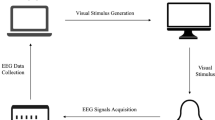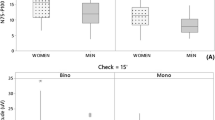Abstract
Purpose
To evaluate stereoscopic visual evoked potentials (S-VEP) in normal controls and in patients with glaucomatous optic nerve damage.
Methods
Computer-generated dynamic random-dot stereograms were used to elicit cortical visual evoked potentials using wireless electric liquid crystal shutter glasses. Normal subjects (n=22) and patients with glaucoma (n=22) were investigated using five different disparities from 9 to 40 arc min. Statistical dependency of measurements with different stimulus at identical patients was adjusted for.
Results
Peak times of onset and offset response of S-VEP can be significantly delayed in glaucomas. A general linear regression model confirmed that differences between patients and normals depend on disparity. S-VEP onset shows no significant difference between controls and glaucomas at 9 arc min disparity. At high disparities, however, peak time of the onset response was significantly (p<0.01) delayed in glaucomas when compared with normals (normals: 125.8±13 ms, glaucomas: 148.2±25.6 ms at 40 arc min).
Conclusions
Visual evoked potential elicited by the onset of a random-dot stereogram can be used for objective measurement of stereoacuity in a clinical setting. Differences between controls and glaucomas in high and low disparities could indicate a stereo-specific deficit in glaucoma.




Similar content being viewed by others
References
Bassi CJ, Galanis JC (1991) Binocular visual impairment in glaucoma. Ophthalmology 98:1406–1411
Bergua A, Horn FK, Jünemann A, et al. (1999) Reduced stereoacuity in open-angle glaucomas. Ophthalmic Res 31 [Suppl 1]:S18
Derrington AM, Lennie P (1984) Spatial and temporal contrast sensitivities of neurons in lateral geniculate nucleus of macaque. J Physiol 357:219–240
DeYoe EA, van Essen DC (1988) Concurrent processing streams in monkey visual cortex. Trends Neurosci 11:219–226
Dunlop DB, Dunlop P, Fenelon R, Neill RA (1983) Evoked responses to distinct and nebulous stereoscopic stimuli. Austr J Ophthalmol 11:295–301
Essock EA, Fechtner RD, Zimmerman TJ, Krebs WK, Nussdorf JD (1996) Binocular function in early glaucoma. J Glaucoma 5:395–405
Fischer B, Krüger J (1979) Disparity tuning and binocularity of single neurons in cat visual cortex. Expl Brain Res 35:1–8
Friedman JR, Kosmorsky GS, Burdfe RM (1985) Stereoacuity in patients with optic nerve disease. Arch Ophthalmol 103:37–38
Fukai S (1984) Topographic visually evoked potentials induced by stereoptic stimulus. Br J Ophthalmol 69:612–617
Gockeln R, Hentschel A, Kretschmann U, Kretschmann U, Hülssner O, Winter R (1999) Local and global stereoscopic processing in low-tension and open-angle glaucoma. Invest Ophthalmol Vis Sci 40:S844
Herpes MJHB, Caberg J, Mol MF (1981) Human cerebral potentials evoked by moving dynamic random-dot stereograms. Electroencephalogr Clin Neurophysiol 52:50–56
Hood DC, Zhang X, Greenstein VC, Kangovi S, Odel JG, Liebmann JM, Ritch R. An interocular comparison of the multifocal VEP (2000) A possible technique for detecting local damage to the optic nerve. Invest Ophthalmol Vis Sci 41:1580–1587
Horn FK, Bergua A, Jünemann A, Korth M (2000) Visual evoked potentials under luminance contrast and color contrast stimulation in glaucoma diagnosis. J Glaucoma 9:428–437
Hubel DH, Wiesel TN (1970) Cells sensitive to binocular depth in area 18 of the macaque monkey cortex. Nature 225:41–42
Hubel DH, Wiesel TN (1973) A re-examination of stereoscopic mechanisms in area 17 of the cat. J Physiol 232:29–30
Jones R (1977) Anomalies of disparity detection in the human visual system. J Physiol 264:621–640
Julesz B (1960) Binocular depth perception of computer-generated patterns. Bell Syst Tech J 39:1125–1162
Julesz B (1962) Towards the automation of binocular depth perception (AUTOMAP-I). In: Popplewell CM (ed) Proc IFIPS, 27 Aug–1Sept 1962, Munich, pp 439-444
Julesz B (1964) Binocular depth perception without familiarity cues. Science 145:356–362
Julesz B (1971) Foundations of cyclopean perception. University of Chicago Press, Chicago
Julesz B, Kropfl W (1982) Binocular neurons and cyclopean visually evoked potentials in monkey man. Ann NY Acad Sci 388:37–44
Kastner C, Fieger A, Heumann C (1996) MAREG and WINMAREG—a tool for marginal regression models. Statistical Software Newsletter in Computational Statistics and Data Analysis 24:237–241
Katz J, Zeger S, Liang KY (1994) Appropriate statistical methods to account for similarities in binary outcomes between fellow eyes. Invest Ophthalmol Vis Sci 35:2461–2465
Kimura I, Maeda K, Akiyama K, Ohde H, Mashima Y, Oguchi Y (1998) The visual evoked potentials in binocular depth perception. Invest Ophthalmol Vis Sci 39:S185
Korth M, Kohl S, Martus P, Sembritzki O (2000) Motion-evoked pattern visual potentials in glaucoma. J Glaucoma 9:376–387
Korth M, Nguyen NX, Jünemann A, Martus P, Jonas JJ (1994) VEP test of the blue-sensitive pathway in glaucoma. Invest Ophthalmol Vis Sci 35:2599–2610
Lehmann D, Julesz B (1978) Lateralized cortical potentials evoked in humans by dynamic random-dot stereograms. Vision Res 18:1265–1271
Livingstone MS, Hubel DH (1987) Psychophysical evidence for separate channels for the perception of form, color, movement and depth. J Neurosc 7:3416–3468
Norcia A, Sutter EE, Tyler C (1985) Electrophysiological evidence for the existence of coarse and fine disparity mechanism in human. Vision Res 25:1603–1611
Ogle KN (1952) Disparity limits of stereopsis. Arch Ophthalmol 48:50–60
Poggio GF, Fischer B (1977) Binocular interaction and depth sensitivity of striate and prestriate cortical neurons of behaving rhesus monkeys. J Neurophysiol 40:1392–1405
Regan D, Spekreijse H (1970) Electrophysiological correlate of binocular depth perception in man. Nature 225:92–94
Regan D, Beverly KI (1973) Electrophysiological evidence for existence of neurons sensitive to direction of depth movements. Nature 246:504–506
Richards W (1971) Anomalous stereoscopic depth perception. J Opt Soc Am 61:410–414
Schiller PH, Malpeli JG (1978) Functional specificity of lateral geniculate nucleus laminae of the rhesus monkey. J Neurophysiol 41:788–797
Schiller PH, Logothetis NK, Charles ER (1988) The role of color-opponent (C-O) and broadband (B-B) channels in vision. Soc Neurosci Abs 14:456
Skrandies W (1987) Visual persistence of stereoscopic stimuli: electric brain activity without perceptual correlate. Vision Res 27:2109–2118
Skrandies W (1991) Contrast and stereoscopic visual stimuli yield lateralized scalp potential fields associated with different neural generators. Electroenceph Clin Neurophysiol 78:274–283
Skrandies W (2001) The processing of stereoscopic information in human visual cortex: psychophysical and electrophysiological evidence. Clin Electroencephalogr 32:152–159
Skrandies W, Vomberg HE (1985) Stereoscopic stimuli activate different cortical neurons in man: electrophysiological evidence. Int J Psychophysiol 2:293–296
Skrandies W, Jedynak A (1999) Learning to see 3-D: psychophysics and brain activity. Neuroreport 10:249–253
Tyler CW (1991) Cyclopean vision. In: Regan D (ed) Binocular vision and visual dysfunction, vol 9. Macmillan, London, pp 38–74
Wesemann W, Klingenberger H, Rassow B (1987) Electrophysiological assesment of the human depth-perception threshold. Graefe’s Arch Clin Exp Ophthalmol 225:429–436
Acknowledgements
This study was supported by DFG, grant SFB 539. We thank J. Jonas and W. Budde for classification of the optic nerve morphology.
Author information
Authors and Affiliations
Corresponding author
Additional information
The authors have no commercial interest in the equipment used in this work. This paper was presented at the ARVO 2000 in poster form
Rights and permissions
About this article
Cite this article
Bergua, A., Horn, F.K., Martus, P. et al. Stereoscopic visual evoked potentials in normal subjects and patients with open-angle glaucomas. Graefe's Arch Clin Exp Ophthalmol 242, 197–203 (2004). https://doi.org/10.1007/s00417-003-0797-3
Received:
Revised:
Accepted:
Published:
Issue Date:
DOI: https://doi.org/10.1007/s00417-003-0797-3




